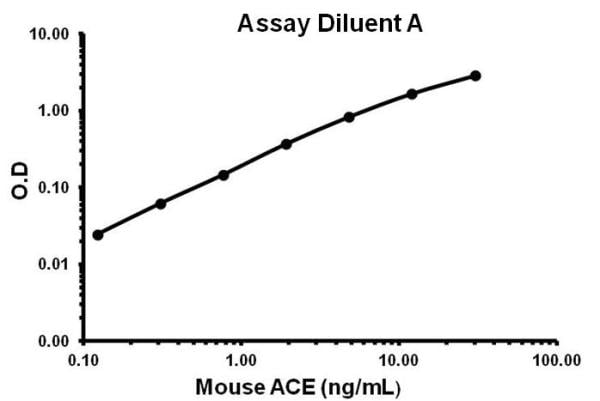Mouse ACE ELISA Kit (CD143) (ab155452)
Key features and details
- Sensitivity: 0.12 ng/ml
- Range: 30 ng/ml - 0.123 ng/ml
- Sample type: Cell culture supernatant, Plasma, Serum
- Detection method: Colorimetric
- Assay type: Sandwich (quantitative)
- Reacts with: Mouse
Properties
-
Storage instructions
Store at -20°C. Please refer to protocols. -
Components 1 x 96 tests 20X Wash Buffer Concentrate 1 x 25ml 5X Assay Diluent B 1 x 15ml 600X HRP-Streptavidin Concentrate 1 x 200µl ACE Microplate (12 x 8 wells) 1 unit Assay Diluent A 1 x 30ml Biotinylated anti-mouse ACE 2 vials Recombinant Mouse ACE Standard (lyophilized) 2 vials Stop Solution 1 x 8ml TMB One-Step Substrate Reagent 1 x 8ml -
Research areas
-
Function
Converts angiotensin I to angiotensin II by release of the terminal His-Leu, this results in an increase of the vasoconstrictor activity of angiotensin. Also able to inactivate bradykinin, a potent vasodilator. Has also a glycosidase activity which releases GPI-anchored proteins from the membrane by cleaving the mannose linkage in the GPI moiety. -
Tissue specificity
Ubiquitously expressed, with highest levels in lung, kidney, heart, gastrointestinal system and prostate. Isoform Testis-specific is expressed in spermatocytes and adult testis. -
Involvement in disease
Ischemic stroke (ISCHSTR) [MIM:601367]: A stroke is an acute neurologic event leading to death of neural tissue of the brain and resulting in loss of motor, sensory and/or cognitive function. Ischemic strokes, resulting from vascular occlusion, is considered to be a highly complex disease consisting of a group of heterogeneous disorders with multiple genetic and environmental risk factors. Note=Disease susceptibility is associated with variations affecting the gene represented in this entry.
Renal tubular dysgenesis (RTD) [MIM:267430]: Autosomal recessive severe disorder of renal tubular development characterized by persistent fetal anuria and perinatal death, probably due to pulmonary hypoplasia from early-onset oligohydramnios (the Potter phenotype). Note=The disease is caused by mutations affecting the gene represented in this entry.
Microvascular complications of diabetes 3 (MVCD3) [MIM:612624]: Pathological conditions that develop in numerous tissues and organs as a consequence of diabetes mellitus. They include diabetic retinopathy, diabetic nephropathy leading to end-stage renal disease, and diabetic neuropathy. Diabetic retinopathy remains the major cause of new-onset blindness among diabetic adults. It is characterized by vascular permeability and increased tissue ischemia and angiogenesis. Note=Disease susceptibility is associated with variations affecting the gene represented in this entry.
Intracerebral hemorrhage (ICH) [MIM:614519]: A pathological condition characterized by bleeding into one or both cerebral hemispheres including the basal ganglia and the cerebral cortex. It is often associated with hypertension and craniocerebral trauma. Intracerebral bleeding is a common cause of stroke. Note=Disease susceptibility is associated with variations affecting the gene represented in this entry. -
Sequence similarities
Belongs to the peptidase M2 family. -
Post-translational
modificationsPhosphorylated by CK2 on Ser-1299; which allows membrane retention. -
Cellular localization
Secreted and Cell membrane. - Information by UniProt
-
Alternative names
- ACE
- ACE 1
- ACE T
see all -
Database links
- Entrez Gene: 11421 Mouse
- SwissProt: P09470 Mouse
- Unigene: 754 Mouse









